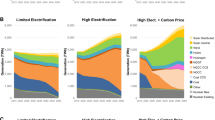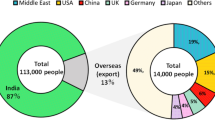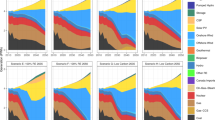Abstract
Accurate assessment of environmental externalities of particulate air pollution is crucial to the design and evaluation of environmental policies. Current evaluations mainly focus on direct damages resulting from exposure, missing indirect co-damages that occur through interactions among the externalities, human behaviours and technologies. Our study provides an empirical assessment of such co-damages using customer-level daily and hourly electricity data of a large sample of residential and commercial consumers in Arizona, United States. We use an instrumental variable panel regression approach and find that particulate matter air pollution increases electricity consumption in residential buildings as well as in retail and recreation service industries. Air pollution also reduces the actual electricity generated by distributed-solar panels. Lower-income and minority ethnic groups are disproportionally impacted by air pollution and pay higher electricity bills associated with pollution avoidance, stressing the importance of incorporating the consideration of environmental justice in energy policy-making.
This is a preview of subscription content, access via your institution
Access options
Access Nature and 54 other Nature Portfolio journals
Get Nature+, our best-value online-access subscription
$32.99 / 30 days
cancel any time
Subscribe to this journal
Receive 12 digital issues and online access to articles
$119.00 per year
only $9.92 per issue
Buy this article
- Purchase on SpringerLink
- Instant access to full article PDF
Prices may be subject to local taxes which are calculated during checkout




Similar content being viewed by others
Data availability
Records of air quality and hourly wind direction were retrieved from pre-generated data files of the United States Environmental Protection Agency at https://aqs.epa.gov/aqsweb/airdata/download_files.html. Climate factors were obtained from Global Surface Summary of the Day at ftp://ftp.ncdc.noaa.gov/pub/data/gsod/. The solar irradiance data from the National Renewable Energy Laboratory’s National Solar Radiation Database is at https://maps.nrel.gov/nsrdb-viewer. The high-frequency electricity data are from the Salt River Project. As they are restricted by a non-disclosure agreement, they are available from the authors upon reasonable request and with permission from the SRP. The county-level trip data are available upon request from the COVID-19 Impact Analysis Platform of the University of Maryland at https://data.covid.umd.edu/about/index.html. Source data are provided with this paper.
Code availability
All data and models are processed in Stata 14.0. The figures are produced in R studio (based on R 3.6.1). All custom code is available on GitHub at https://github.com/hepannju/Increase-in-domestic-electricity-consumption-from-particulate-air-pollution.
References
Graff Zivin, J. & Neidell, M. The impact of pollution on worker productivity. Amer. Econ. Rev. 102, 3652–3673 (2012).
Chang, T., Graff Zivin, J., Gross, T. & Neidell, M. Particulate pollution and the productivity of pear packers. Am. Econ. J. Econ. Policy 8, 141–169 (2016).
Levinson, A. Valuing public goods using happiness data: the case of air quality. J. Public Econ. 96, 869–880 (2012).
Chen, X. Smog, cognition and real-world decision-making. Int. J. Health Policy Manag. 8, 76–80 (2019).
Zhang, X., Chen, X. & Zhang, X. The impact of exposure to air pollution on cognitive performance. Proc. Natl Acad. Sci. USA 115, 9193–9197 (2018).
de Marco, A. et al. Impacts of air pollution on human and ecosystem health, and implications for the National Emission Ceilings Directive: insights from Italy. Environ. Int. 125, 320–333 (2019).
Chay, K. & Greenstone, M. Does air quality matter? Evidence from the housing market. J. Polit. Economy 113, 376–424 (2005).
Goulder, L. & Schein, A. Carbon Taxes Vs. Cap and Trade: a Critical Review (National Bureau of Economic Research, 2013); https://doi.org/10.3386/w19338
Sun, C., Kahn, M. E. & Zheng, S. Self-protection investment exacerbates air pollution exposure inequality in urban China. Ecol. Econ. 131, 468–474 (2017).
Zivin Graff, J. & Neidell, M. Days of haze: environmental information disclosure and intertemporal avoidance behavior. J. Environ. Econ. Manage. 58, 119–128 (2009).
Ward, A. L. S. & Beatty, T. K. Who responds to air quality alerts? Environ. Resource Econ. 65, 487–511 (2016).
Zhang, J. & Mu, Q. Air pollution and defensive expenditures: evidence from particulate-filtering facemasks. J. Environ. Econ. Manage. 92, 517–536 (2018).
Chen, S., Oliva, P. & Zhang, P. The Effect of Air Pollution on Migration: Evidence from China (National Bureau of Economic Research, 2017); https://doi.org/10.3386/w24036
Graff Zivin, J. & Neidell, M. Environment, health, and human capital. J. Econ. Lit. 51, 689–730 (2013).
Sexton, A. L. Health and Environmental Implications of Americans’ Time Use Responses to External Stimuli: Essays on Air-Quality Alerts and Daylight Savings Time. PhD thesis, Univ. of Minnesota (2012).
Tong, Z., Chen, Y., Malkawi, A., Liu, Z. & Freeman, R. B. Energy saving potential of natural ventilation in China: the impact of ambient air pollution. Appl. Energy 179, 660–668 (2016).
Cao, X., Dai, X. & Liu, J. Building energy-consumption status worldwide and the state-of-the-art technologies for zero-energy buildings during the past decade. Energy Build. 128, 198–213 (2016).
Hiller, C. Factors influencing residents’ energy use—a study of energy-related behaviour in 57 Swedish homes. Energy Build. 87, 243–252 (2015).
de Nazelle, A. et al. Improving estimates of air pollution exposure through ubiquitous sensing technologies. Environ. Pollut. 176, 92–99 (2013).
Kumar, P. et al. Indoor air quality and energy management through real-time sensing in commercial buildings. Energy Build. 111, 145–153 (2016).
Streets, D. G., Wu, Y. & Chin, M. Two‐decadal aerosol trends as a likely explanation of the global dimming/brightening transition. Geophys. Res. Lett. https://doi.org/10.1029/2006GL026471 (2006).
Sweerts, B. et al. Estimation of losses in solar energy production from air pollution in China since 1960 using surface radiation data. Nat. Energy 4, 657–663 (2019).
Li, X., Wagner, F., Peng, W., Yang, J. & Mauzerall, D. L. Reduction of solar photovoltaic resources due to air pollution in China. Proc. Natl Acad. Sci. USA 114, 11867–11872 (2017).
Tessum, C. W. et al. Inequity in consumption of goods and services adds to racial–ethnic disparities in air pollution exposure. Proc. Natl Acad. Sci. USA 116, 6001–6006 (2019).
Nair, G., Gustavsson, L. & Mahapatra, K. Factors influencing energy efficiency investments in existing Swedish residential buildings. Energy Policy 38, 2956–2963 (2010).
Liang, J., Liu, P., Qiu, Y., Wang, Y. D. & Xing, B. Time-of-use electricity pricing and residential low-carbon energy technology adoption. Energy J. 41, 1944–9089 (2020).
White, L. V. & Sintov, N. D. Health and financial impacts of demand-side response measures differ across sociodemographic groups. Nat. Energy 5, 50–60 (2020).
Phoenix now the 5th-largest city in the US, census says. Fox News https://www.foxnews.com/us/phoenix-now-the-5th-largest-city-in-the-us-census-says (2017).
Ridlington, E. & Leavit, C. Trouble in the Air—Millions of Americans Breathe Polluted Air (Environment America Research & Policy Center, 2018); https://environmentarizonacenter.org/sites/environment/files/reports/Trouble%20in%20the%20Air%20vAZ.pdf
Li, Y., Pizer, W. A. & Wu, L. Climate change and residential electricity consumption in the Yangtze River Delta, China. Proc. Natl Acad. Sci. USA 116, 472–477 (2019).
Reames, T. G. Targeting energy justice: exploring spatial, racial/ethnic and socioeconomic disparities in urban residential heating energy efficiency. Energy Policy 97, 549–558 (2016).
Bednar, D. J., Reames, T. G. & Keoleian, G. A. The intersection of energy and justice: modeling the spatial, racial/ethnic and socioeconomic patterns of urban residential heating consumption and efficiency in Detroit, Michigan. Energy Build. 143, 25–34 (2017).
Ng, L. C., Musser, A., Persily, A. K. & Emmerich, S. J. Indoor air quality analyses of commercial reference buildings. Build. Environ. 58, 179–187 (2012).
Arceo, E., Hanna, R. & Oliva, P. Does the effect of pollution on infant mortality differ between developing and developed countries? Evidence from Mexico City. Econ. J. 126, 257–280 (2016).
Freeman, R., Liang, W., Song, R. & Timmins, C. Willingness to pay for clean air in China. J. Environ. Econ. Manage. 94, 188–216 (2019).
Janke, K. Air pollution, avoidance behaviour and children’s respiratory health: evidence from England. J. Health Econ. 38, 23–42 (2014).
Tribby, C. P., Miller, H. J., Song, Y. & Smith, K. R. Do air quality alerts reduce traffic? An analysis of traffic data from the Salt Lake City metropolitan area, Utah, USA. Transp. Policy 30, 173–185 (2013).
Noonan, D. S. Smoggy with a chance of altruism: the effects of ozone alerts on outdoor recreation and driving in Atlanta. Policy Stud. J. 42, 122–145 (2014).
Air Quality Pre-generated Data Files (United States Environmental Protection Agency, 2013–2018); https://aqs.epa.gov/aqsweb/airdata/download_files.html#Raw
Global Summary of the Day (National Centers for Environmental Information, 2013–2018); ftp://ftp.ncdc.noaa.gov/pub/data/gsod/
National Solar Radiation Database (National Renewable Energy Laboratory, accessed 7 January 2019); https://maps.nrel.gov/nsrdb-viewer
Zhang, P., Deschenes, O., Meng, K. & Zhang, J. Temperature effects on productivity and factor reallocation: evidence from a half million Chinese manufacturing plants. J. Environ. Econ. Manage. 88, 1–17 (2018).
Deschênes, O. & Greenstone, M. Climate change, mortality, and adaptation: evidence from annual fluctuations in weather in the US. Am. Econ. J. Appl. Econ. 3, 152–185 (2011).
Zhang, L. et al. An interactive COVID-19 mobility impact and social distancing analysis platform. Preprint at https://www.medrxiv.org/content/10.1101/2020.04.29.20085472v1 (2020).
University of Maryland COVID-19 Impact Analysis Platform (Maryland Transportation Institute, 2020); https://data.covid.umd.edu
Who Is ‘Middle Income’ and ‘Upper Income’ in 2014? (Pew Research Center, 2016); https://www.pewsocialtrends.org/2016/05/11/americas-shrinking-middle-class-a-close-look-at-changes-within-metropolitan-areas/st_2016-05-12_middle-class-geo-03/
Barwick, P. J., Li, S., Deyu, R. & Zahur, N. B. Air Pollution, Health Spending and Willingness to Pay for Clean Air in China (Semantic Scholar, 2018); https://pdfs.semanticscholar.org/7819/8c81716d00638acd74fadf1c12a19202d7c1.pdf
Sager, L. Estimating the effect of air pollution on road safety using atmospheric temperature inversions. J. Environ. Econ. Manage. 98, 102250 (2019).
Deryugina, T., Heutel, G., Miller, N. H., Molitor, D. & Reif, J. The mortality and medical costs of air pollution: evidence from changes in wind direction. Amer. Econ. Rev. 109, 4178–4219 (2019).
Zheng, S., Cao, J., Kahn, M. E. & Sun, C. Real estate valuation and cross-boundary air pollution externalities: evidence from Chinese cities. J. Real Estate Finance Econ. 48, 398–414 (2014).
Anderson, M. L. As the wind blows: the effects of long-term exposure to air pollution on mortality. J. Eur. Econ. Assoc. 18, jvz051 (2019).
Clements, A. L. et al. Source identification of coarse particles in the Desert Southwest, USA using Positive Matrix Factorization. AtmosPollut. Res. 8, 873–884 (2017).
Acknowledgements
Funding for this research was provided by the National Science Foundation under grant no. 1757329. We thank J.H. Scofield, C. Canfield, Y. Li, H. Zhang and the seminar participants at the Center for Global Sustainability of University of Maryland, Division of Resource Economics and Management of University of West Virginia, and the Institute of Energy, Environment and Economy of Tsinghua University for their helpful comments during the preparation of this paper.
Author information
Authors and Affiliations
Contributions
All the authors conceived the paper and designed the research. P.H., J.L. and Y.Q. designed the analysis methods, performed the analyses and wrote and revised the paper. B.X. processed the data. Q.L. reviewed several draughts and made revisions.
Corresponding authors
Ethics declarations
Competing interests
The authors declare no competing interests.
Additional information
Publisher’s note Springer Nature remains neutral with regard to jurisdictional claims in published maps and institutional affiliations.
Supplementary information
Supplementary Information
Supplementary Tables 1–23 and Fig. 1.
Source data
Source Data Fig. 1
Source data of Fig. 1.
Source Data Fig. 2
Source data of Fig. 2.
Source Data Fig. 3
Source data of Fig. 3.
Source Data Fig. 4
Source data of Fig. 4.
Rights and permissions
About this article
Cite this article
He, P., Liang, J., Qiu, Y.(. et al. Increase in domestic electricity consumption from particulate air pollution. Nat Energy 5, 985–995 (2020). https://doi.org/10.1038/s41560-020-00699-0
Received:
Accepted:
Published:
Issue date:
DOI: https://doi.org/10.1038/s41560-020-00699-0
This article is cited by
-
Foreign direct investment and ecological efficiency in Pakistan: a new perspective on the pollution haven hypothesis
International Journal of Environmental Science and Technology (2024)
-
CarbonMonitor-Power near-real-time monitoring of global power generation on hourly to daily scales
Scientific Data (2023)
-
Influence of rainfall-induced diabatic heating on southern rainfall-northern haze over eastern China in early February 2023
Science China Earth Sciences (2023)
-
A measurement strategy to address disparities across household energy burdens
Nature Communications (2022)
-
The Effect of Rebate and Loan Incentives on Residential Heat Pump Adoption: Evidence from North Carolina
Environmental and Resource Economics (2022)



